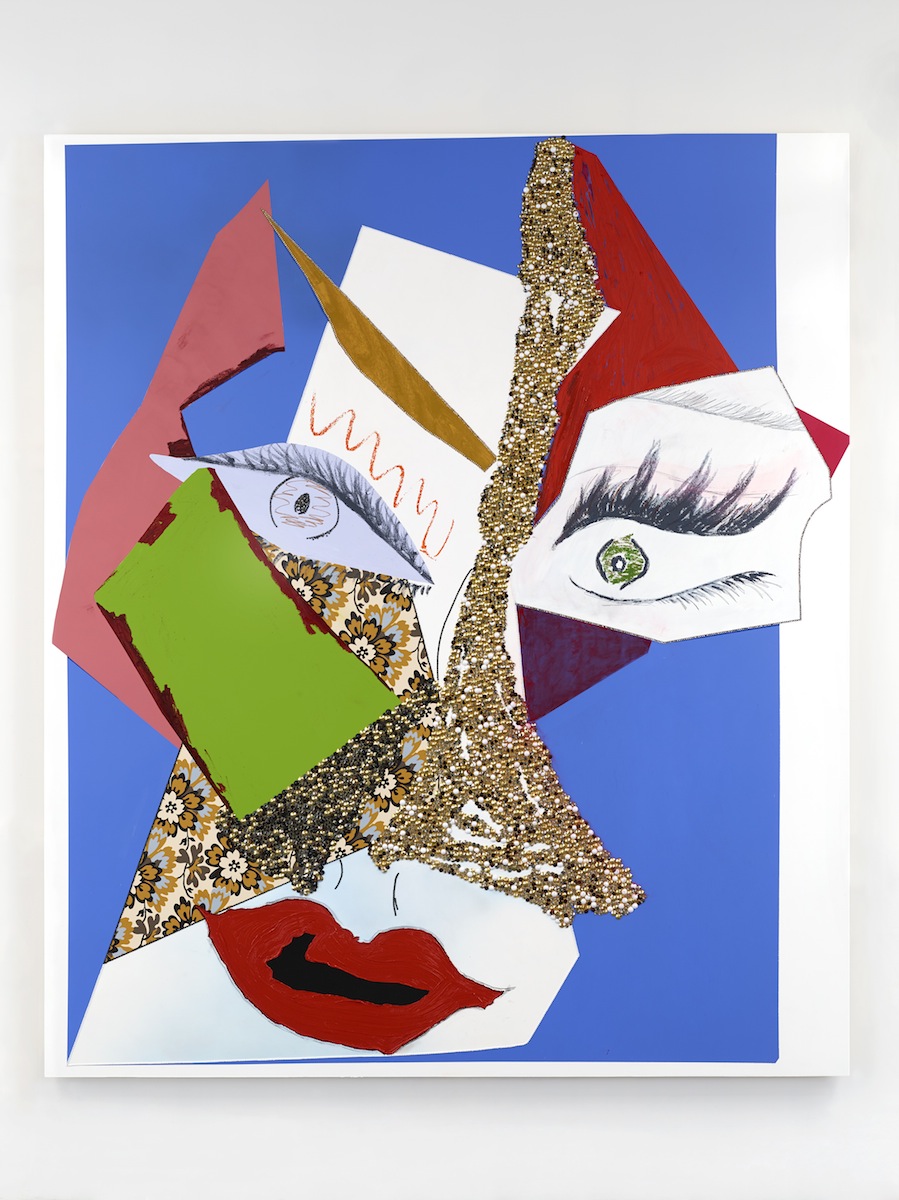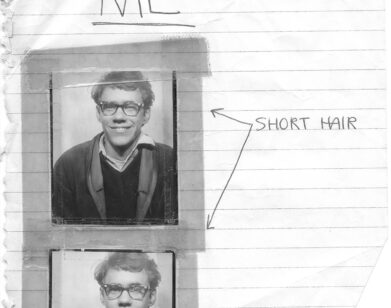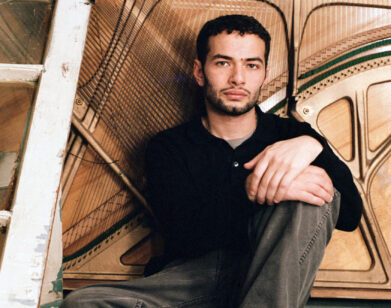Making Up with Mickalene Thomas
In his popular song “Picasso Baby,” and the accompanying performance-art film, Jay Z considers the exchange of energy between an artist and his audience, a cultural tête-a-tête of sorts, then shouts, “I’m the modern day Pablo.” However, a blink-and-you’ll-miss-it look at the film might prove otherwise. Enter Mickalene Thomas, the unassuming young lady in Jay-approved “all-black-everything” invited to dance in the round with the hip-hop mogul.
Thomas, a Yale graduate and noted contemporary mixed-media artist, is perhaps most widely recognized for her acrylic-and-crystal-emblazoned portraits of powerful black women, some reclining in the nude, in lively environments evocative of Spike Lee’s Crooklyn. Ever the chameleon, Thomas was commissioned to apply her signature patchwork motif to the cover art of Solange Knowles’ limited edition EP, True, and honored her own late mother and longtime muse, the fashion model Sandra Bush, with an international exhibition and HBO special directed by Thomas, Happy Birthday to a Beautiful Woman.
This evening, Thomas will unveil “Tête de Femme,” her fourth solo show at Chelsea’s Lehmann Maupin Gallery. Not unlike Picasso’s portraits of his beloved and betrothed, Thomas’ latest works are variations on a theme—identity, self-presentation, and beauty ideals—in a society preoccupied with youth and “perfection.” We met with Thomas on the eve of her opening, installation in progress, and inquired about her newly whittled-down aesthetic, use of collage and silkscreen, and focus on the face.
TEDDY TINSON: Mickalene, the show is exquisite. â??Nine oversized portraits of glammed-to-the-max women. Considering the history of your controlled portraiture, how does one evolve to this place?
MICKALENE THOMAS: It’s tricky. For me, a lot of this particular show is about paring down and focusing on the figure and the portraits abstractly. It came about from a project that I did a couple of years ago, a pop-up show at the Proposition gallery. It was celebration of everyone I work with to come to the forefront—those who have helped me along my path and assisted me in terms of making the work. The works in this show came from the collaboration with my makeup artist Vincent Oquendo. He does the makeup for my subjects during sittings.
TINSON: Does he ever do your maquillage?
THOMAS: Occasionally, yes. For my birthday, and occasions, I call him and say, “Hey, my turn, do my makeup!” He’s a fantastic artist, and I’ve worked with him for over five years.
TINSON: So the project was a collaboration in the truest sense.
THOMAS: Absolutely. Yes, A real collaboration. It was very much about us, actually them, the other artists and assistants, not me. Vincent was shy at first, he said, “Oh, I don’t make art. I don’t know what to do.” I said, “Hey, why don’t you come to my studio and we’ll just play. I’ll make something, you make a mark, I’ll make something again, you make a mark, and let’s just see where it goes.” I was making these collages and we focused the premise and the inspiration of the work.
TINSON: How’d you determine the makeup premise?
THOMAS: We looked at photographs of models wearing makeup, including looks Victorâ?? did for some of my photo shoots. I told him, “let’s think about how the makeup is applied, the angles of their face, and just play.” I started making the collages and Vincent said, “Oh, that’s cool, I don’t have to do anything.” I said, “No, you need to do something! Why don’t you use your makeup, that’s paint, right?”
TINSON: Aha, it just came to you naturally—Vincent’s applied art form. Similarly, Karl Lagerfeld uses makeup for all his illustrations at Chanel.
THOMAS: Exactly. Vincent would take the blush and the lipstick and he would paint. And then I would muck it up. [laughs] He’d look at me and say, “You just messed up everything I did.” “Well, that’s the play.”
TINSON: How long did he put up with you “messing up” his beauty concepts?
THOMAS: [laughs] We made a series of seven. Some of the works in the new show are based on that experiment. I altered a few once they became paintings, but that’s how it started.
TINSON: I noticed your characteristically kitschy titles are missing. The pieces are simply untitled, save for their catalogue numbers, but there is one named “Carla,” which serves as the “lead” of the group of nine portraits.â??
THOMAS: Yes, Carla Camacho. She’s actually a partner hereâ?? at Lehmann Maupin. She stopped by my studio and I made this collage of her.
TINSON: How large were the original collages? Full scale?
THOMAS: Small, about eight by 10 inches. As people came to my studio, women that I would have conversations with, women that I photograph, I would make collages of them very quickly. It started from looking at my previous work, working with another artist friend, and re-contextualizing the portrait—what one might see and think of the person, the energy of the person, the essence of the person.
TINSON: Is there a particular ethnicity ascribed to the women?
THOMAS: It could be anyone. Anyone can bring their own notions to this because it could be them. It’s geometric shapes that come together to create a form. In a way, they are of black women, but they’re not.
TINSON: Does each work present an individual woman, or is it an amalgam?
THOMAS: Each work is of an individual woman, and yes, it is about the ethnicity, but then it’s not because it’s removed. It’s the visceral play, a transformation and open-ended dialogue.
TINSON: Other than the women you encountered, what were some of your inspirations?
THOMAS: [referring to Untitled, #10—a pink, neon green and lapis blue striped work] I was inspired by early Interview covers, playing with bold color and abstractions, in addition to an homage to a certain ’80s New Wave aesthetic.
TINSON: I’m especially intrigued by the Warhol flower as this lady’s eye. How did you incorporate such strong iconography into your work?
THOMAS: We silk-screened her eye. I wanted to use the image, however iconic, as the gaze and turn it to how we see things. The opening of the eye is the flower, coming into view.
TINSON: Does this flower live or die in your eye?
THOMAS: Oh, this flower is alive!
TINSON: Eternal life.
THOMAS: Yes. I gave a stack of blank, black-and-white Warhol cards to my two-year-old daughter. She drew on the flower, and I silk-screened her marks onto the wooden canvas. I have some new work in my studio with these layers, the paint and the collage, and the rhinestones and the silk-screening within it. It’s very exciting to look at what you’re making at the moment and take it into the older works.
TINSON: The old informs new, and vice versa. While on the subject of eyes, Toni Morrison’s The Bluest Eye comes to mind. I don’t see any blue eyes, per se, but lots of green and brown. There’s even an iris shaped like the African continent. Like the flower, do these eyes also represent life and growth?
THOMAS: Precisely. All the work has a dialogue. It’s integrated, no separation between the two.
TINSON: I’m intrigued by the title “Tête de Femme,” echoing Picassoâ??’s piece from the 1930s of Marie-Thérèse Walter. Your work typically focuses on the entire female form. Why move to the bust portrait, the head? Is it a celebration or exploration?
THOMAS: Exploration. Focusing on the face, the portrait and the gaze. “Tête de Femme.” It’s not just what’s presented, it’s the viewer bringing their perspective to it, and the scale. About you looking at the face. And the face looking back at you.â??
TINSON: The lips are particularly built up in Untitled #1. â??What does the layering represent? â??Iâ??s it lushness? Is it chaos?
THOMAS: â??It’s excitement. It’s rhythm. It’s â??jazz. It’s â??music allowing these moments to play a part when â??one is not hearing the other, they just come togeâ??ther. It’s like… [Thomas begins to scat like Ella Fitzgeraldâ??].
TINSON: Let’s discuss the diptych against the back wall. What’s the purpose of showing this woman in two?
â??THOMAS: â??I wanted to break up this wholeness, the viewer isâ?? getting the lips or getting the eyes, but not at once.
TINSON: â??Is that a commentary on separation of the heart and the mind, editing â??what we say versus â??what we think? â??
â??THOMAS: â??Yes, it’s about that back and forth. This is the tête de femme for the viewer, where they’re looking while analyzing another part.
â??TINSONâ??: Tell me about the grid on the square portrait. It’s really my favorite.
Tâ??HOMAS: It’s like an African mask. A presentation of how we want to be perceived. Makeup is just one big mask. â??I looked at the history of Picassoâ??, of cubism, and theâ?? root of African culture, symmetry.â?? The idea of the grid. These two languages coming together. Modernism â??and â??African cultuâ??re integrating, becoming one. The hiâ??stoâ??ry of the square. This was originally a â??rectangular image. We cropped into it and put it on the wooden â??square.
â??TINSON: Is this your interpretation of the “selfie,” the camera focus grid, image expertly cropped and spliced, confronting the viewer head-on?
â??THOMAS: I love that! Yes, my response to Instagram.
TINSON: â??Are the portraits gender-neutral?
â??THOMAS: â??Yes, they’re gender-neutral. Although they started from a particular groâ??up, these portraits can be anything or anyone. Some fabulous dandy, some fabulousâ?? transgender person. Or a beautiful woman, â??whâ??ite, blaâ??ck, or Aâ??sian. It’s not a celebration, just accepting beauty as it is.
â??TINSON: Do you feel this piece [Untitled #3] best captures the essence of this show?â??
â??THOMAS: It’s actually my favorite.
TINSON: Why is that?
THOMAS: It reminds me of â??my mother.
TINSON: What aspects of your mother’s personality?
THOMAS: Sheâ?? had a beautiful long nose; this shape [Thomas points to an elongated stroke of sienna] is a repâ??reâ??sentation of her. And the eyes, the gaping of the mouth, for me, it exudes her energy.
â??TINSON:â?? â??Seeing the â??various angles â??of the collages, did you consider hâ??ow the materials move into each other, reshaping or “contouring” one’s â??features and personal truths vs. how they want to be perceived?â??
THOMAS: â??There’s a great desire for people to alter themselves, but it’s alsoâ?? the art of transformation. â??”â??I want a bigger butt, I want bigger boobs.”â?? The artifice interests me—how we’râ??e capable of altering ourselves. There’s a creative element that’s very intriguing. Black women, for hundreds of years, have had to confront the idea “beauty” and “what it means to be beautiful.”
â??TINSON: â??Because of societal pressure?â??
â??THOMAS: Yes! Beauty has always been an â??element of discussion for black women, whether or not we were the ones having the conversationâ??. We’veâ?? had to contend with the element of our hair. â??Beauty pros and cons have â??câ??hanged the world of how we perceive each other. Some people â??go to great lenâ??gths to bleach themselves to conform to the norm, the whiteness, and all the complexities. Within the darkness and goodness of it, there’s still the great mystery of â??”â??why?” It’s essentially all about how we’re perceived in the world. Out of necessity, black women have always had to consider others’ perceptions of a certain beauty ideal, just starting with the skin color. Beauty was so heavily important in my family, something I had to contend with.
TINSON: Did it start as a little girl backstage at the fashion shows, when you’d get dressed with your mother?
THOMAS: Absolutely. You can’t escape that. All those experiences allow me to make what I’m making today. I grew up with that. There’s a reason why I express that in my art. I’m trying to figure it out myself. How can I if I don’t have the conversation.
TINSON: Would you consider this exhibit an open journal, a stream of consciousness?
THOMAS: Yes. I’m on this journey called discovery.
“TÊTE DE FEMME” IS ON VIEW THROUGH AUGUST 28 AT LEHMANN MAUPIN GALLERY, 540 WEST 26TH STREET.







